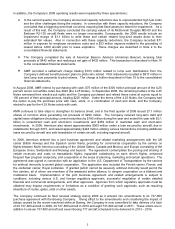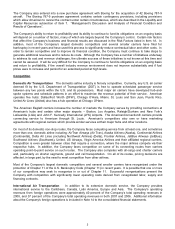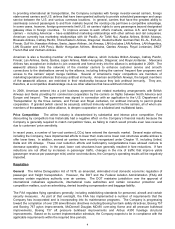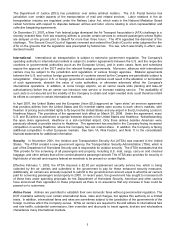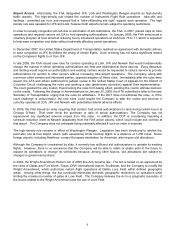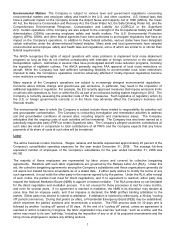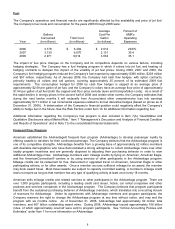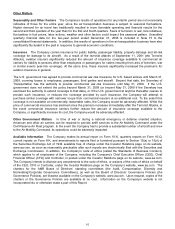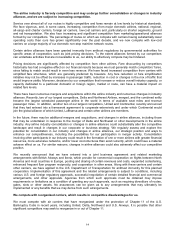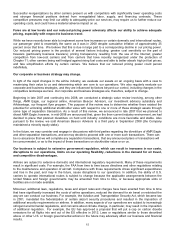American Airlines 2008 Annual Report Download - page 9
Download and view the complete annual report
Please find page 9 of the 2008 American Airlines annual report below. You can navigate through the pages in the report by either clicking on the pages listed below, or by using the keyword search tool below to find specific information within the annual report.6
Airport Access Historically, the FAA designated JFK, LGA and Washington Reagan airports as high-density
traffic airports. The high-density rule limited the number of Instrument Flight Rule operations - take-offs and
landings - permitted per hour and required that a “take-off/landing slot right” support each operation. The high
density rule was repealed for JFK and LGA; however both airports remain subject to operating restrictions.
In order to remedy congestion at LGA due to elimination of slot restrictions, the FAA, in 2007, placed caps on total
operations and required carriers at LGA to hold operating authorizations. In January 2009, the FAA announced a
voluntary program at LGA aimed at reducing hourly scheduled operations at LGA from 75 to 71, which is expected
to help ease congestion and delay without materially affecting carrier operations.
In December 2007, the United States Department of Transportation reached an agreement with domestic airlines
to ease congestion at JFK by shifting the timing of certain flights. Such re-timing has not had a significant impact
on the Company’s flights to or from JFK.
In late 2008, the FAA issued new rules for carriers operating at LGA, JFK and Newark that would fundamentally
change the manner in which operating authorizations are held and distributed at those airports. Every departure
and landing would require an authorization and existing carriers would be requested to reduce service to provide
authorizations for auction to other carriers without increasing total airport operations. The Company, along with
numerous other carriers and interested parties, opposed adoption of these rules. Immediately after the rules were
issued, the ATA and others petitioned for judicial review in the United States Court of Appeals for the District of
Columbia Circuit challenging the rules and seeking a stay (preliminary injunction) against their implementation.
The court granted the stay motion, thus blocking the rules from taking effect, pending the court’s ultimate decision
on the merits. Following the change in Administrations on January 20, 2009, the ATA submitted a letter to the new
Secretary of Transportation urging that the rules be withdrawn. If the DOT does not withdraw the rules, or if the
court challenge is unsuccessful, the new rules could require the Company to alter the routes and services it
currently operates at LGA, JFK and Newark with potentially material adverse effects.
In 2006, the FAA issued an order requiring that carriers hold arrival authorizations to land during certain hours at
Chicago O’Hare. That order limits the purchase or sale of arrival authorizations. The Company has not
experienced any significant adverse impact from this order. In addition, the DOT is considering imposing a
schedule reduction order at Newark (separately from the FAA action above), which could include slot controls at
that airport. The Company does not anticipate being materially affected if such an order is imposed.
The high-density rule remains in effect at Washington Reagan. Legislation has been introduced to abolish the
perimeter rule at that airport, which (with exceptions) limits nonstop flights to a distance of 1,250 miles. Some
foreign airports, including Heathrow, a major European destination for American, also require slot allocations.
Although the Company is constrained by slots, it currently has sufficient slot authorizations to operate its existing
flights. However, there is no assurance that the Company will be able to retain or obtain slots in the future to
expand its operations or change its schedules because, among other factors, slot allocations are subject to
changes in government policies.
In 2006, the Wright Amendment Reform Act of 2006 (the Act) became law. The Act is based on an agreement by
the cities of Dallas and Fort Worth, Texas, DFW International Airport, Southwest, and the Company to modify the
Wright Amendment, which authorizes certain flight operations at Dallas Love Field within defined geographic
areas. Among other things, the Act eventually eliminates domestic geographic restrictions on operations while
limiting the maximum number of gates at Love Field. The Company believes the Act is a pragmatic resolution of
the issues related to the Wright Amendment and the use of Love Field.





